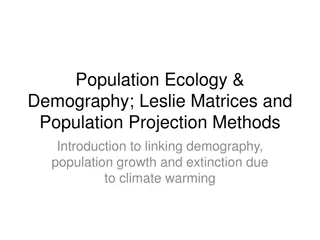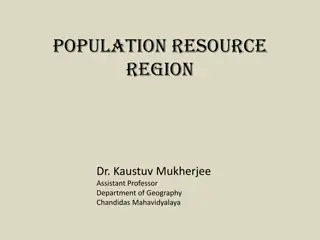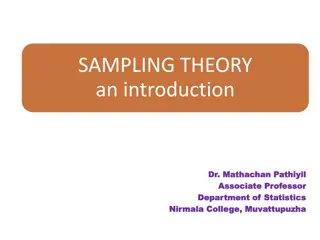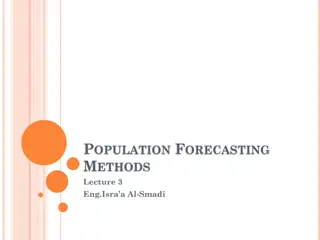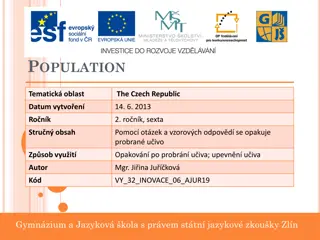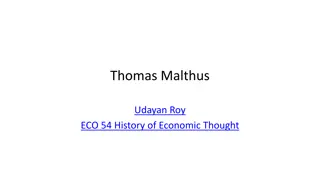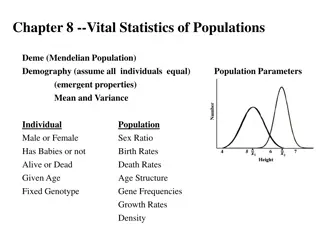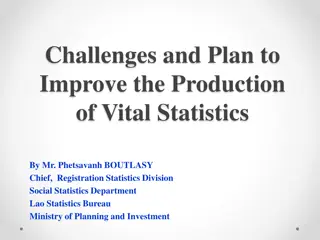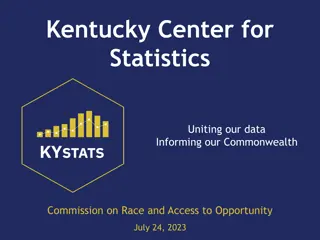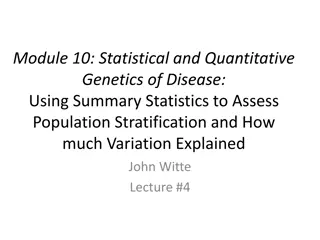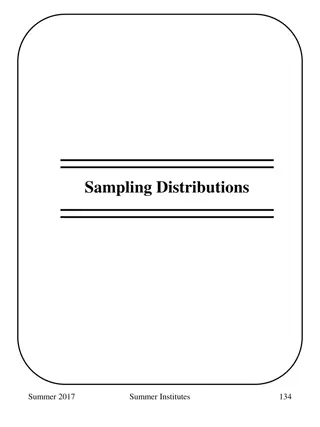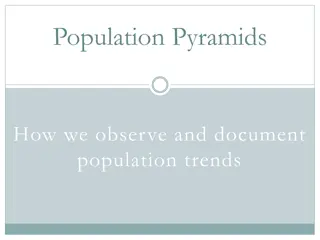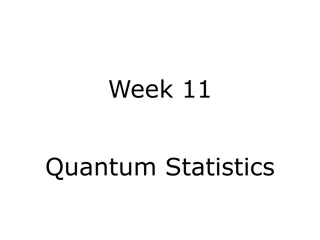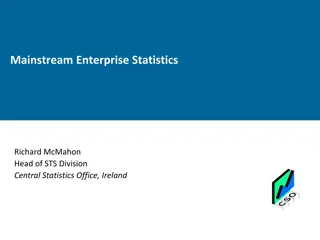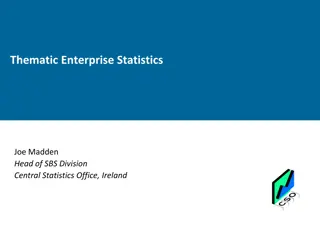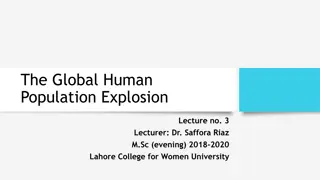Task Team on International Trade Statistics Progress Overview
The Secretariat of the Task Team on International Trade Statistics, under the United Nations Committee of Experts on Business and Trade Statistics, is actively involved in revising manuals on international trade statistics. Established in 2021, the team focuses on enhancing the integration between t
3 views • 28 slides
Overview of the South African National Population Register
The South African National Population Register (NPR) is a vital system maintained by the Department of Home Affairs. It serves to record and update information on the country's resident population, issue identity documents, and handle related administrative tasks. The NPR has evolved over the years
2 views • 16 slides
Understanding Population Ecology and Demography Through Leslie Matrices
Explore the critical aspects of population ecology and demography, focusing on factors influencing abundance, population growth, regulation, and the impacts of climate change. Learn about population projections, growth models, age-structured populations, and data requirements for estimating populati
4 views • 35 slides
Impact of Human Population Growth on Environment and Welfare
The rapid growth of the human population is placing immense pressure on the environment, leading to increased demand for resources like food, water, and shelter. The effects of human activity on the environment have escalated significantly over the years due to population expansion. High birth rates
0 views • 8 slides
Introduction to Sampling in Statistics
Sampling in statistics involves selecting a subset of individuals from a population to gather information, as it is often impractical to study the entire population. This method helps in estimating population characteristics, although it comes with inherent sampling errors. Parameters represent popu
2 views • 24 slides
Understanding Population-Resource-Region Relationship: A Geographical Perspective
Explore the intricate relationship between population, resources, and regions through a geographical lens. Delve into classifications based on population, resources, and technology, with examples from different countries and regions. Discover the concepts of optimum population, over-population, and
1 views • 11 slides
Understanding Demography: Population Trends and Analysis
Demography is the study of population size, distribution, and composition, encompassing elements such as mortality, natality, migration, and demographic forces. Population census plays a crucial role in collecting and analyzing demographic data, with methods like De Jure and De Facto census. Inter-c
6 views • 21 slides
Understanding Statistics: An Overview of Business Statistics in MSMSR
Learn about the core concepts of statistics in business through this MSMSR lecture plan module covering topics such as the introduction to statistics, definition of statistics, functions, scope, limitations of data, classification of data, and tabulation of data. Discover how statistics plays a cruc
1 views • 37 slides
Comparing 1750 to 1900: Population Growth in Britain
The population of Britain saw a significant increase between 1750 and 1900. In 1750, the population was 7 million, and by 1900, it had grown to 37 million. This represented an 87% increase. The number of people living in towns also rose from 13% to a higher percentage. Factors contributing to this g
0 views • 6 slides
Population Resource Regions and Zelinsky's Classification
Geographers have long studied the relationship between population growth and resource adequacy, leading to the concept of Population Resource Regions (PRR) by W. Zelinsky. Zelinsky identified five types of PRR based on population-resource ratios, ranging from Type A with high resource utilization po
0 views • 8 slides
Population Distribution in Different Regions of Pakistan
The population distribution in Pakistan varies significantly among different regions, with certain provinces like Punjab and Sindh having higher population densities compared to Baluchistan and FATA. The rural areas are also categorized into different population density regions based on the number o
0 views • 14 slides
Understanding Basic Statistics in Research and Evidence-Based Practice
Basic statistics play a crucial role in research and evidence-based practice. Descriptive statistics help summarize data, while inferential statistics make inferences about populations based on samples. Various types of statistics like hypothesis testing, correlation, confidence intervals, and signi
3 views • 15 slides
Understanding Sampling Theory: An Introduction to Statistical Surveys
Statistical surveys play a crucial role in collecting information to fulfill specific needs across various fields such as population demographics, labor statistics, agriculture, industry, and trade. A statistical survey involves investigating unknown characteristics of a population, focusing on para
0 views • 41 slides
Enhancing Population and Vital Statistics in Botswana: Insights from Expert Group Meeting
Explore Botswana's efforts in improving population and vital statistics through autonomous bodies and decennial censuses, like the upcoming 2021 census. Learn about demographic indicators and population counts shaping the country's data collection methods.
5 views • 11 slides
Methods of Population Forecasting for Urban Development
Designing water supply and sanitation schemes for cities requires accurate population forecasting. Factors influencing population changes include births, deaths, migration, and annexation. Various methods like Arithmetic Increase, Geometric Increase, and Ratio Method are used to predict population g
4 views • 24 slides
Understanding the Concept of Population and Unit Stock
The concept of population revolves around all organisms of the same species living in a specific area capable of interbreeding. It is essential to differentiate between sample populations and real populations to accurately study their attributes such as birth rates, death rates, and spatial dimensio
0 views • 15 slides
Population Policy of Pakistan: Vision, Goals, and Strategies
The Population Policy of Pakistan, adopted in 2002, aims to stabilize the population by 2020 through a focus on reducing fertility rates and promoting family planning. The policy outlines goals such as achieving a balance between resources and population, increasing awareness of rapid population gro
0 views • 11 slides
Exploring Population Data of the Czech Republic
The data presents insights into the population of the Czech Republic, including demographics, language distribution, religious beliefs, literacy rates, life expectancy, and urban population percentages. The population pyramid reveals a dominance of people in the age group of 20-49, with longer life
0 views • 8 slides
Thomas Malthus and His Theory on Population Growth
Thomas Robert Malthus, an influential economist, proposed a theory on population growth in the 18th century. His theory suggested that population grows exponentially while food production increases at a slower rate, leading to inevitable food scarcity. Malthus also discussed the concept of preventiv
2 views • 19 slides
Understanding Vital Population Statistics and Demography
Exploring vital statistics of populations with a focus on Mendelian populations and demography, analyzing factors like sex ratio, birth rates, death rates, age structure, gene frequencies, growth rates, and population density. The content delves into emergent properties, mean and variance population
0 views • 9 slides
Development of Quantum Statistics in Quantum Mechanics
The development of quantum statistics plays a crucial role in understanding systems with a large number of identical particles. Symmetric and anti-symmetric wave functions are key concepts in quantum statistics, leading to the formulation of Bose-Einstein Statistics for bosons and Fermi-Dirac Statis
1 views • 15 slides
Challenges and Plan to Improve Vital Statistics by Mr. Phetsavanh BOUTLASY
Mr. Phetsavanh BOUTLASY, Chief of Registration Statistics Division at the Lao Statistics Bureau, discusses the legislative framework, national statistics system development strategy, challenges faced in vital statistics, and plans to enhance statistical production. The strategy aims for sustainable
0 views • 11 slides
UK Statistics Authority's Role in Ensuring Trustworthy Health and Care Statistics in England
The UK Statistics Authority, established under the Statistics and Registration Service Act 2007, plays a crucial role in promoting the production and publication of high-quality official statistics in the field of health and care. They emphasize the importance of trustworthy, valuable statistics tha
0 views • 9 slides
Louisiana Parish Population Statistics 2010
Louisiana Parish Population Statistics for the year 2010 reveal varying population numbers across different regions. The data provides insights into demographic changes and trends over the past decade. The total population change by parish and age group highlights shifts in different age brackets. T
0 views • 42 slides
Improvement of Population and Vital Statistics Metadata in the Demographic Yearbook System
The Demographic Yearbook system focuses on enhancing population and vital statistics metadata to ensure accurate and concise reflection of population concepts across 230+ countries. It involves annual collection of official national population estimates, vital statistics, and UN international travel
0 views • 16 slides
Kentucky Center for Statistics - Data and Opportunity Insights
Kentucky Center for Statistics presents research data on population trends, education, workforce, and poverty rates in Kentucky, highlighting disparities by race. The analyses cover demographic shifts from 2010 to 2023, including youth population, poverty rates, inmate demographics, K-12 education s
0 views • 32 slides
Statistical and Quantitative Genetics of Disease: Understanding Population Stratification
This lecture explores the use of summary statistics to assess population stratification and the impact of LD on association studies in statistical and quantitative genetics. It delves into LD scores, genomic inflation, polygenic inheritance, and separating SNP heritability from population stratifica
0 views • 29 slides
Understanding Logistic Growth in Population Dynamics
Explore the logistic growth equation and its applications in modeling population dynamics. Dive into the concept of sigmoidal growth curves and the logistic model, which reflects population growth with limits. Learn how to calculate population change using the logistic growth equation and understand
0 views • 26 slides
Understanding the Key Distinctions in Statistics
In statistics, the crucial difference between sample and population data shapes how we interpret information and draw conclusions. By generalizing sample data to the population, statisticians can estimate true means and variances with confidence. Sample means help us infer about the population, alth
0 views • 32 slides
Insights on 2019 Gender and Veteran Demographics
Analysis from the 2019 Annual Averages of the Current Population Survey reveals significant statistics regarding gender and veteran populations in the United States. Data indicates that veterans comprise 7.5% of the overall population, with women veterans totaling almost 2 million. Women veterans ma
0 views • 48 slides
Overview of Population Measures and District Data from Census Reports
The census reports various population measures including total population, voting age population, and citizen voting age population. The data includes breakdowns by ethnicity for each trustee district. Changes in voting and citizen voting age population percentages are also provided. Data is sourced
0 views • 4 slides
Vital Statistics Questionnaire and Response Rates Analysis
This information pertains to the vital statistics questionnaire and response rates discussed during the Third Regional Workshop on Production and Use of Vital Statistics in 2014 in Daejeon, Republic of Korea. It covers the collection of vital statistics related to fertility, general mortality, infan
0 views • 13 slides
Understanding Population Pyramids for Analyzing Population Trends
Population pyramids are graphical illustrations that showcase the distribution of age groups within a population, segmented by gender. By observing and documenting the patterns of population pyramids, one can discern trends such as rapid growth, slow growth, or negative growth, which are influenced
0 views • 7 slides
Understanding Parameters, Statistics, and Statistical Estimation in Statistics
In statistics, we differentiate between parameters and statistics, where parameters describe populations and statistics describe samples. Statistical estimation involves drawing conclusions about populations based on sample data. The Law of Large Numbers explains the relationship between sample stat
0 views • 12 slides
Quantum Statistics in Physical Systems
In the realm of quantum statistics, various ensembles such as the grand canonical ensemble play a crucial role in describing the behavior of systems like gases and biological molecules. Understanding concepts such as Gibbs factor, chemical potential, and the probabilities of states being occupied sh
0 views • 19 slides
Central Statistics Office, Ireland Enterprise Statistics Overview
The Central Statistics Office (CSO) in Ireland conducts various enterprise surveys to collect data on short-term business statistics, annual structural business statistics, producer prices, employment, and earnings. These surveys provide valuable national indicators, fulfill legal obligations, and c
0 views • 11 slides
Population Generation from Statistics Using Genetic Algorithms with MIST + INSPYRED
This article discusses the use of Genetic Algorithms along with MIST and INSPYRED for generating a mock population from published statistics. It covers the basics of INSPYRED and MIST, their applications in population generation, and the computing power needed for running simulations over the cloud.
0 views • 15 slides
Maine Workforce and Population Trends Analysis 2014-2024
Maine's workforce and population outlook from 2014 to 2024 reveals a decline in births, resulting in an aging population and workforce imbalance. The state faces challenges due to low birth rates, negative natural population change, and minimal net migration, impacting labor force growth and total p
0 views • 31 slides
Enterprise Statistics and Energy Data in Ireland
Thematic Enterprise Statistics division headed by Joe Madden at the Central Statistics Office in Ireland covers various aspects including Access to Finance, Energy Statistics, Financial Sector Data, Foreign Affiliates Statistics, ICT Enterprise Figures, Innovation and R&D Statistics, Outsourcing Dat
0 views • 21 slides
The Global Human Population Explosion: Causes and Implications
The lecture explores the rapid increase in the global human population post-World War II, analyzing factors such as birth rates, mortality rates, and life expectancy. Various counterarguments are presented, including the debate on population growth benefits, ethical concerns over reproductive interf
0 views • 20 slides


